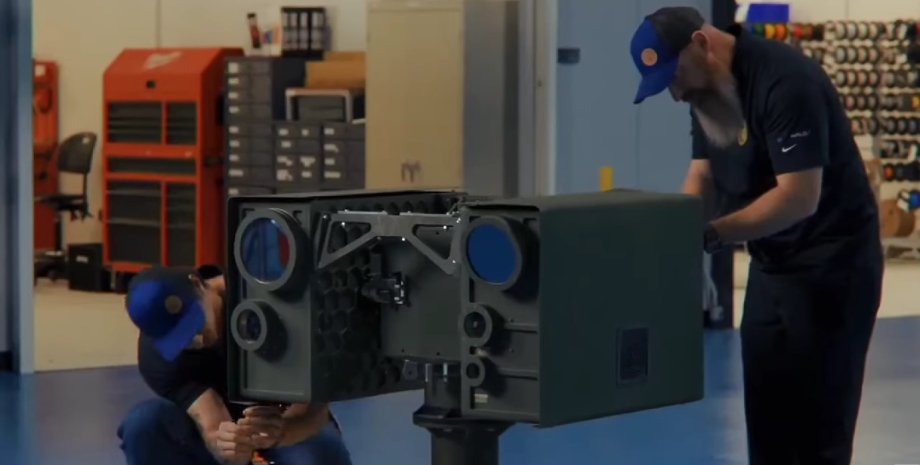
 By Victor Duda
By Victor Duda
In May, information emerged that the US military with the help of a laser knocked several drones during a battle in an unmistakable place in the Middle East, which was the first case of successful use of such weapons. The US Army representative was unable to confirm or comment on the event through "operational security goals", military insiders attribute the success of a "paletened high-energy laser system"-Palletized High Energy Laser System or abbreviated P-Hel.
"This is a landmark milestone in the development of high-energy laser weapons," says Mark Nas, Director General DirectED ENERGY Consultants and former head of the laser unit of the US Air Force Research Laboratory. Back in 1897, the fantasy writer Herbert Wells conceived the Martian thermal ray as the perfect weapon that can be cited as easily as a spotlight and which will destroy everything touched.
Scientists also have long been talking about the great prospects of laser weapons, but could not realize the potential for various reasons. From the beginning of the 20th century, they have studied many different concepts of "death rays", mostly unsuccessfully, although attempts to use directed radio waves to defeat goals have led to the creation of radars. Albert Einstein Einstein introduced the theory of laser in 1917, and military funding helped in 1960 the first demonstration.
However, even after that, the process stuck on the spot for a long time due to technical problems. The fact is that it is very difficult and costly to start a ray of sufficient power to destroy an enemy aircraft, tank or ship. But it is quite realistic and practically to burn the rocket shell, forcing it to fall without flying to the target.
Therefore, the lasers were considered as a remedy against the USSR rocket threat, and after the Caribbean crisis, US President John Kennedy assigned laser anti -missile defense "Higher National Priority". On November 13, 1973, engineers finally managed to knock down the target with the help of Kirtland Air Base in New Mexico-it was a small radio-controlled aircraft.
But the problems did not disappear, they were insufficient durability, reliability and capacity of laser installations suitable for combat. The Multi-Bill-Bill-Billion Airborne Laser project, which was based on a megawatt class system on the aircraft, was tested in 2002, and in 2014 it was quietly "buried" through low range. There are now more than 30 different programs related to powerful laser weapons in the United States.
The US military in the Middle East was not impressed by the Directed Energy Maneuver Short-Range Air Defense (De M-SHORAD), perhaps because it is difficult to keep the ray for a long time for harm. According to Popular Mechanics, the only system that has worked properly is P-Hel. It is based on the laser Locust system from Bluehalo's defensive company. The equipment weighing 1.
5 tons is equipped with a laser emitter, is provided with the help of the XBOX controller and provides a 360 degree air defense. The Locust system produces 20 kW of power - quite a few compared to other complexes. For example, DM M-SHORAD and XN-1 LAWS issues 50 kW and Iron Beam as much as 100 kW. The secret of success of Locust is to focus this power at a point in a half -inch, which allows to burn steel of the same thickness.
"When you have good stability and control, you get a very effective interaction with less power. The difference in capture, giving and managing the beam," explained Bluehalo CEO Jonathan Manimier. Bluehalo has been specializing in laser communications for more than forty years. Its systems are provided by high -speed data transmission channels to the International Space Station and US military satellites.
This made it possible to accumulate extensive experience in managing the beam and keeping it for a fast moving goal. This is what provided the efficiency of Locust. The artificial intelligence -based beam control system allows Locust to recognize and classify drones to hit the most vulnerable place. According to Jonathan Manimier, the quadcopter laser can burn the rotor, and the larger drones can cut the wing as if a saw.
Locust can handle any unmanned vehicles, including large shock drones used by Russia and Iran. P-Hel is just one of the decisions, the company also installed its complex on military vehicles. The emergence of working laser weapons, consider analysts, is very appropriate. According to some estimates, in Ukraine, there are up to 80% of the battlefield in Ukraine. In January 2024, three soldiers were killed in the US military base from the border with Syria and more than 40 more were injured.
"The threat was five years ago, but we had other priorities. Now the priority of this threat has risen to the level when urgent measures are being taken," Mark Nose said. The great advantage of laser weapons is the cheapness and virtually unlimited ammunition, which is determined only by the amount of electricity available.
Currently, a large part of the US tactical air defense is provided by Styinger's anti -aircraft missiles, which are very effective against combat aircraft and helicopters, but cost $ 480,000 apiece. In addition, there are too few of them to resist flocks of drones. Lasers should be the last line of defense in a multi -level system to quickly affect a large number of enemy drones, using the speed of light, that is, laser radiation.
It is believed that mirror surfaces reflect the lasers and prevent them from attacking the target. Mark Nose denied this theory. According to him, today developers with Bluehalo have not found any material to cover drones, which would significantly affect the burning rate, during the test the difference was less than one second. At the same time, reflecting surfaces make it easier to track goals in the sky.
After laser weapons have proven efficiency in battle, the military can quickly deploy it on a large scale. Mark Nose shared that the US Army plans to hold the final competitions between different complexes, and they would follow the contracts for mass supply. In this case, the military will receive on a laser installation on a platoon. To reliably protect the sky, several systems may be required to get the sectors of the overlapping fire.










All rights reserved IN-Ukraine.info - 2022